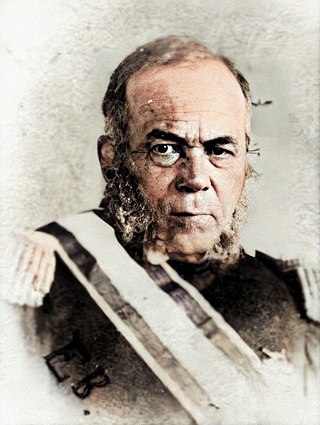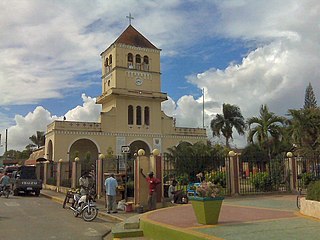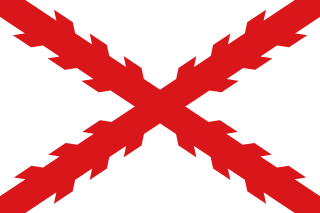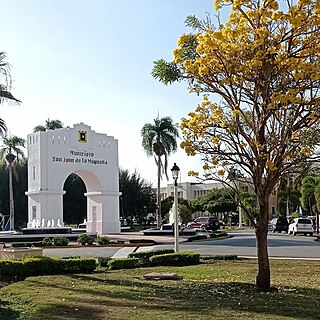
Pedro Santana y Familias, 1st Marquess of Las Carreras was a Dominican military commander and royalist politician who served as the president of the junta that had established the First Dominican Republic, a precursor to the position of the President of the Dominican Republic, and as the first President of the republic in the modern line of succession. A traditional royalist who was fond of the Monarchy of Spain and the Spanish Empire, he ruled as a governor-general, but effectively as an authoritarian dictator. During his life he enjoyed the title of "Libertador de la Patria."

Domingo Ortiz de Rosas y García de Villasuso, 1st Marquis of Poblaciones (1683–1756) was a Spanish soldier who served as governor of Chile.

Bayaguana is a municipality (municipio) of the Monte Plata province in the Dominican Republic.

The Archdiocese of Burgos is Latin Metropolitan sees of the Catholic Church in Spain.

The Captaincy General of Santo Domingo was the first colony in the New World, established by Spain in 1492 on the island of Hispaniola. The colony, under the jurisdiction of the Real Audiencia of Santo Domingo, was granted administrative powers over the Spanish possessions in the Caribbean and most of its mainland coasts, making Santo Domingo the principal political entity of the early colonial period.

The mayor of Valenzuela, a highly urbanized city in northern Metro Manila, Philippines, is the official head and chief executive of Valenzuela. He leads on enforcing city ordinances and improving public services. The mayor has a term of office of three years, but has a maximum electoral tenure of three consecutive terms. Inaugural holder of the office was Pío Valenzuela (1869–1956), served from 1899 to 1901, whom the city received its name.

San Juan is a province of the Dominican Republic. Before 1961 it was known as Benefactor. San Juan is the Republic's largest province, bearing a size of 3,569 square kilometers, and it is landlocked.
Gonzalo Piña Ludueña or Lidueña was a Spanish conquistador and colonial administrator in the Province of Venezuela between 1597 and 1600.

José Núñez de Cáceres y Albor was a Dominican politician and writer. He is known for being the leader of the independence movement against Spain in 1821 and the only president of the short-lived Republic of Spanish Haiti, which existed from December 1, 1821, to February 9, 1822. This period was known as the ephemeral independence because it quickly ended with the Unification of Hispaniola under the Haitian government.
Diego de Osorio y Villegas was a sixteenth-century governor of Venezuela Province (1589–1597), the Venezuela Province being a part of the Spanish Empire. He was governor at the time of the Preston Somers Expedition during which an English force found Caracas by way of a secret route through the mountains.
Diego de Escobar y Osorio was Governor of Paraguay from February 2, 1647 – February 22, 1649.
Rosa Carolina Mejía Gómez de Garrigó is a Dominican politician, economist, and businesswoman. She is the current mayor of Distrito Nacional, the first woman to assume the position.

Campuzano-Polanco was a prominent family from the Captaincy General of Santo Domingo with origins in Santiago de los Caballeros. During the colonial era of the Hispaniola, their members and descendants went on to occupy high political, military and ecclesiastical positions, locally and outside the Island, as well as in the metropolis of Spain. Their merits extend since the beginning and until the end of the colony.

The Devastations of Osorio refer to a period in the colonial history of the Captaincy General of Santo Domingo, modern day Dominican Republic in the early 17th century. In order to eliminate the contraband trade in the north and the northwest parts of the island, the Spanish monarch Felipe III sent an order to the then-governor of Hispaniola, Antonio de Osorio, to depopulate those parts of the island and to relocate the inhabitants to the vicinity of Santo Domingo in the southeast of the island. The Devastations were carried out between 1605 and 1606.

The Snitch Cartel: Origins is a Colombian crime drama streaming television series developed for Caracol Televisión by Asier Aguilar. It is based on the book El Cartel de los Sapos by Andrés López López, and focuses specifically on the lives of the Villegas brothers, better known as Los Caballeros de Cali. The series is set in two eras, starring first Juan Pablo Urrego, and Sebastián Osorio playing the Villegas brothers in their youth, and later being replaced by Gustavo Angarita Jr., and Carlos Manuel Vega in his adulthood.










